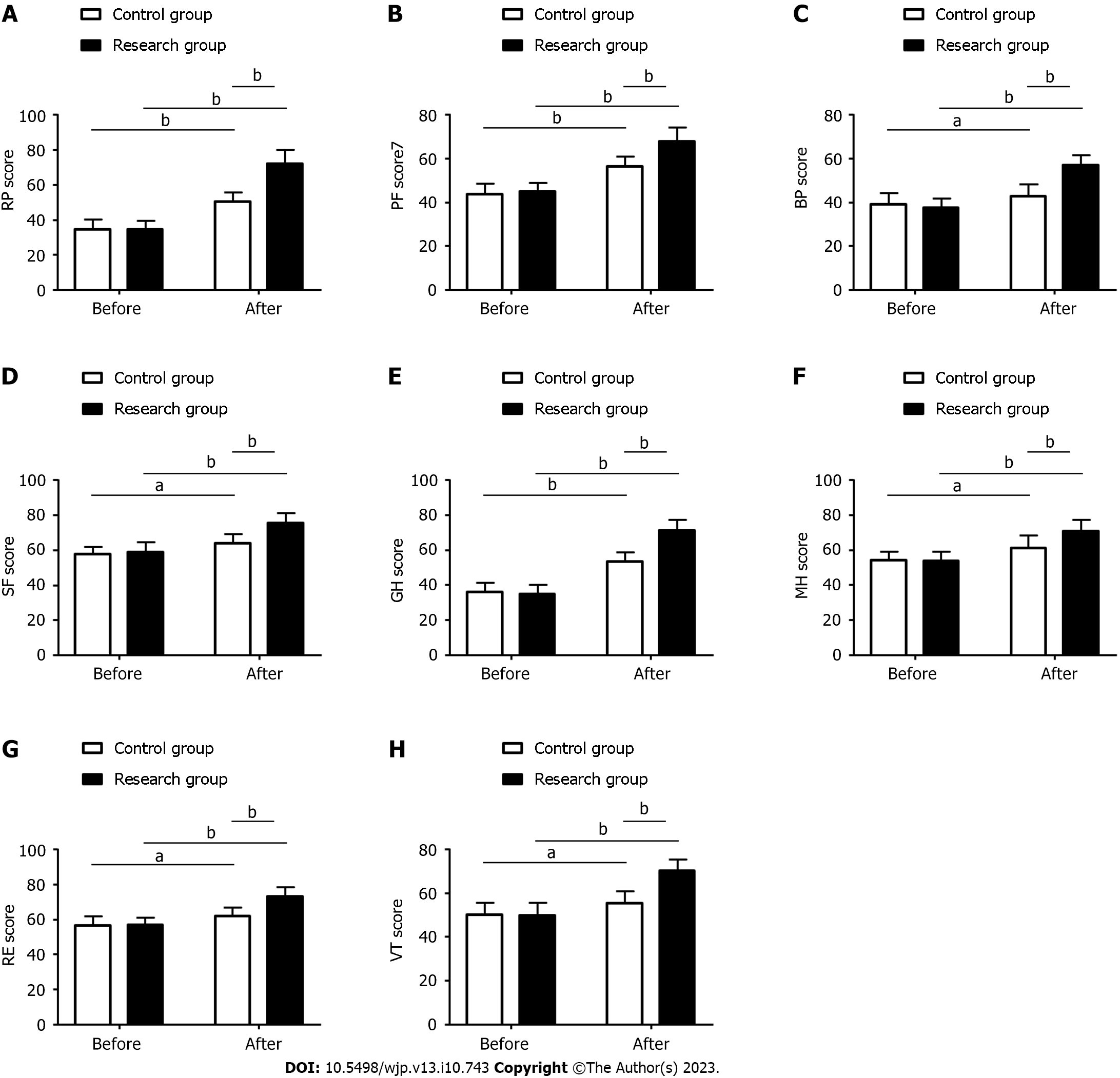Copyright
©The Author(s) 2023.
World J Psychiatry. Oct 19, 2023; 13(10): 743-752
Published online Oct 19, 2023. doi: 10.5498/wjp.v13.i10.743
Published online Oct 19, 2023. doi: 10.5498/wjp.v13.i10.743
Figure 1 Analysis of the influence of ankle flexion and extension exercises on knee osteoarthritis patients’ psychological state.
A: The research group had a postinterventional Self-Rating Depression Scale score that was lower than the preinterventional value and that of the control group; B: The research group had a postinterventional Self-Rating Anxiety Scale score that was lower than the preinterventional value and that of the control group. Note: aP < 0.05; bP < 0.01. SDS: Self-Rating Depression Scale; SAS: Self-Rating Anxiety Scale.
Figure 2 Analysis of the impact of ankle flexion and extension exercises on knee osteoarthritis patients’ activities of daily living.
The research group had a postinterventional activities of daily living score that was lower than the preinterventional value and that of the control group. aP < 0.05; bP < 0.01. ADL: Activities of daily living.
Figure 3 Analysis of the influence of ankle flexion and extension exercises on knee osteoarthritis patients’ knee joint function.
The research group had a postinterventional Lysholm score that was higher than the preinterventional value and that of the control group. aP < 0.05; bP < 0.01.
Figure 4 Analysis of the impact of ankle flexion and extension exercises on knee osteoarthritis patients’ pain and fatigue.
A: The research group had a postinterventional Visual Analog Scale score that was lower than the preinterventional value and that of the control group; B: The research group had a postinterventional MFI score that was lower than the preinterventional value and that of the control group. aP < 0.05; bP < 0.01. VAS: Visual Analog Scale; MFI: Multidimensional Fatigue Inventory.
Figure 5 Analysis of the influence of ankle flexion and extension exercises on knee osteoarthritis patients’ quality of life.
A: The research group had a postinterventional Role-physical score that was higher than the preinterventional value and that of the control group; B: The research group had a postinterventional physical functioning score that was higher than the preinterventional value and that of the control group; C: The research group had a postinterventional bodily pain score that was higher than the preinterventional value and that of the control group; D: The research group had a postinterventional social functioning score that was higher than the preinterventional value and that of the control group; E: The research group had a postinterventional general health score that was higher than the preinterventional value and that of the control group; F: The research group had a postinterventional mental health score that was higher than the preinterventional value and that of the control group; G: The research group had a postinterventional role-emotional score that was higher than the preinterventional value and that of the control group; H: The research group had a postinterventional vitality score that was higher than the preinterventional value and that of the control group. aP < 0.05; bP < 0.01. PF: Physical functioning; RP: Role-physical; BP: Bodily pain; SF: Social functioning; GH: General health; MH: Mental health; RE: Role-emotional; VT: Vitality.
- Citation: Liu Y, Chen R, Zhang Y, Wang Q, Ren JL, Wang CX, Xu YK. Clinical value of ankle flexion and extension exercises combined with a psychological intervention in knee osteoarthritis. World J Psychiatry 2023; 13(10): 743-752
- URL: https://www.wjgnet.com/2220-3206/full/v13/i10/743.htm
- DOI: https://dx.doi.org/10.5498/wjp.v13.i10.743













